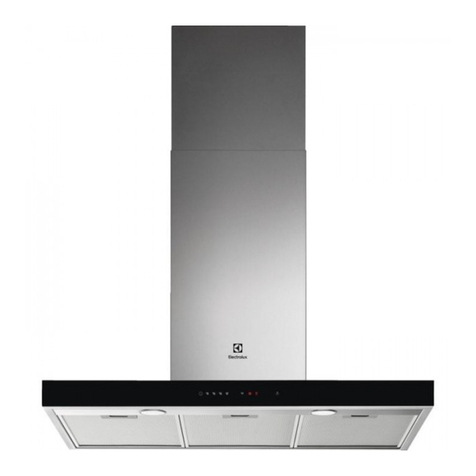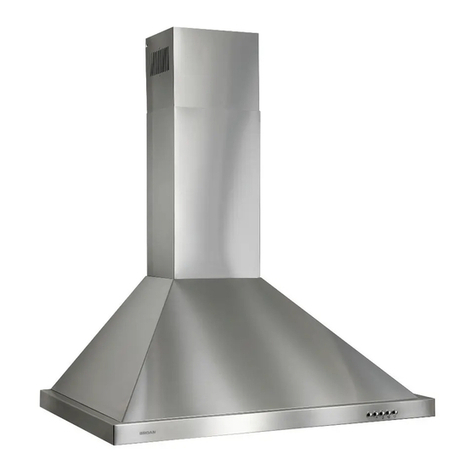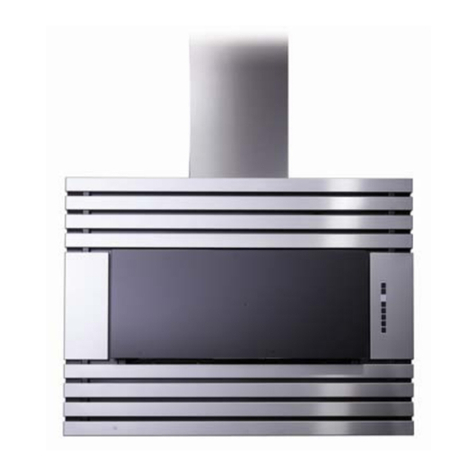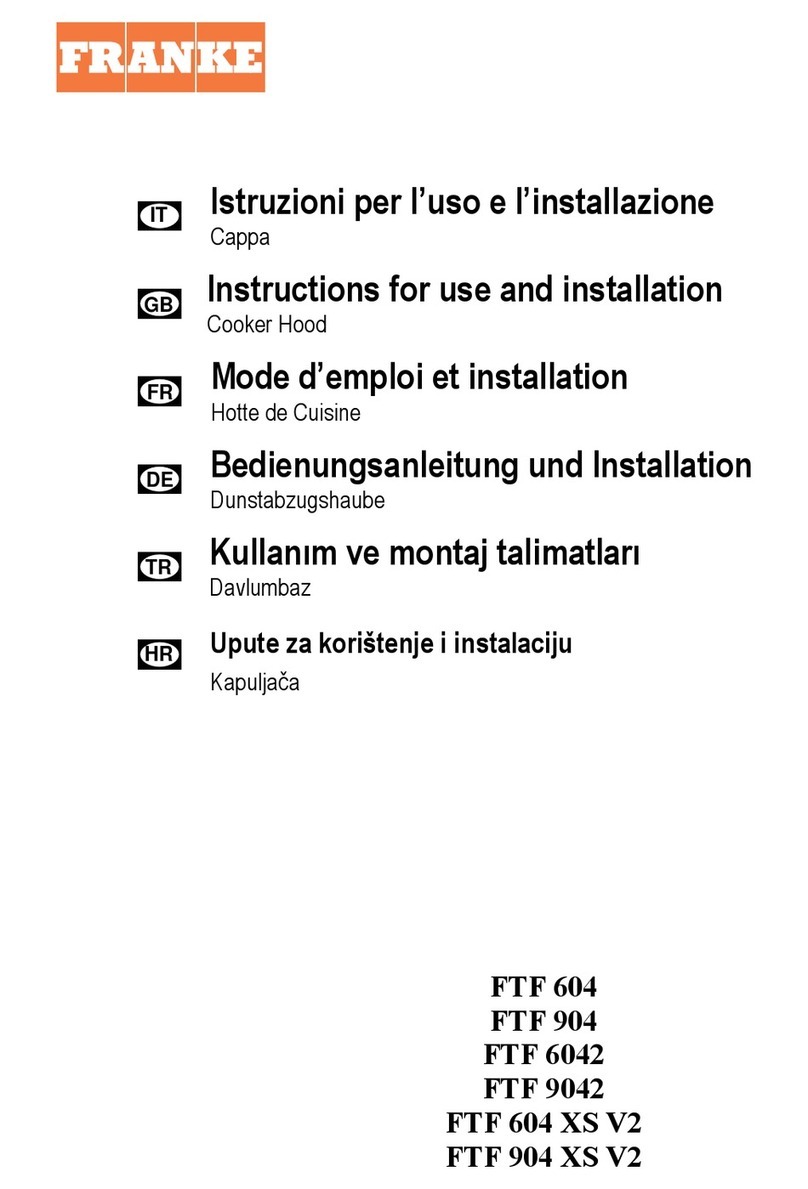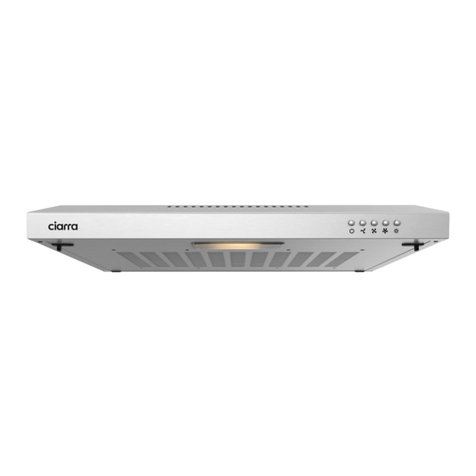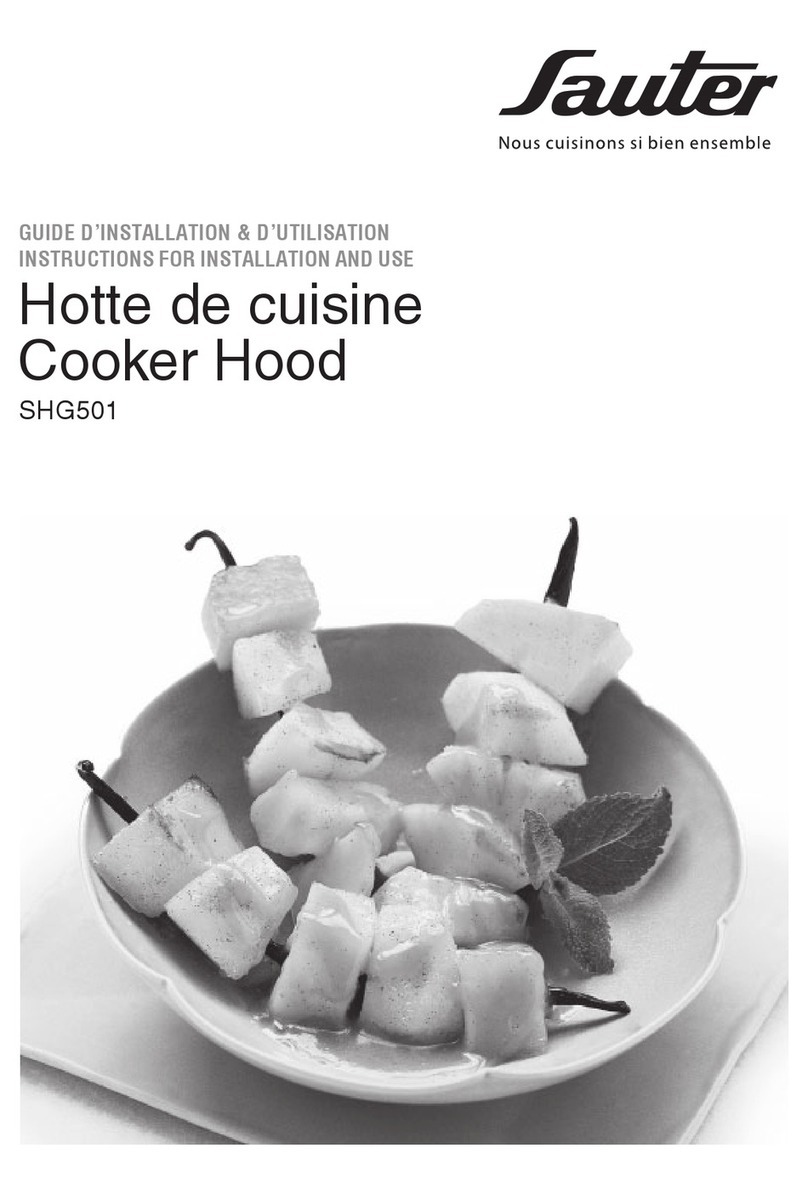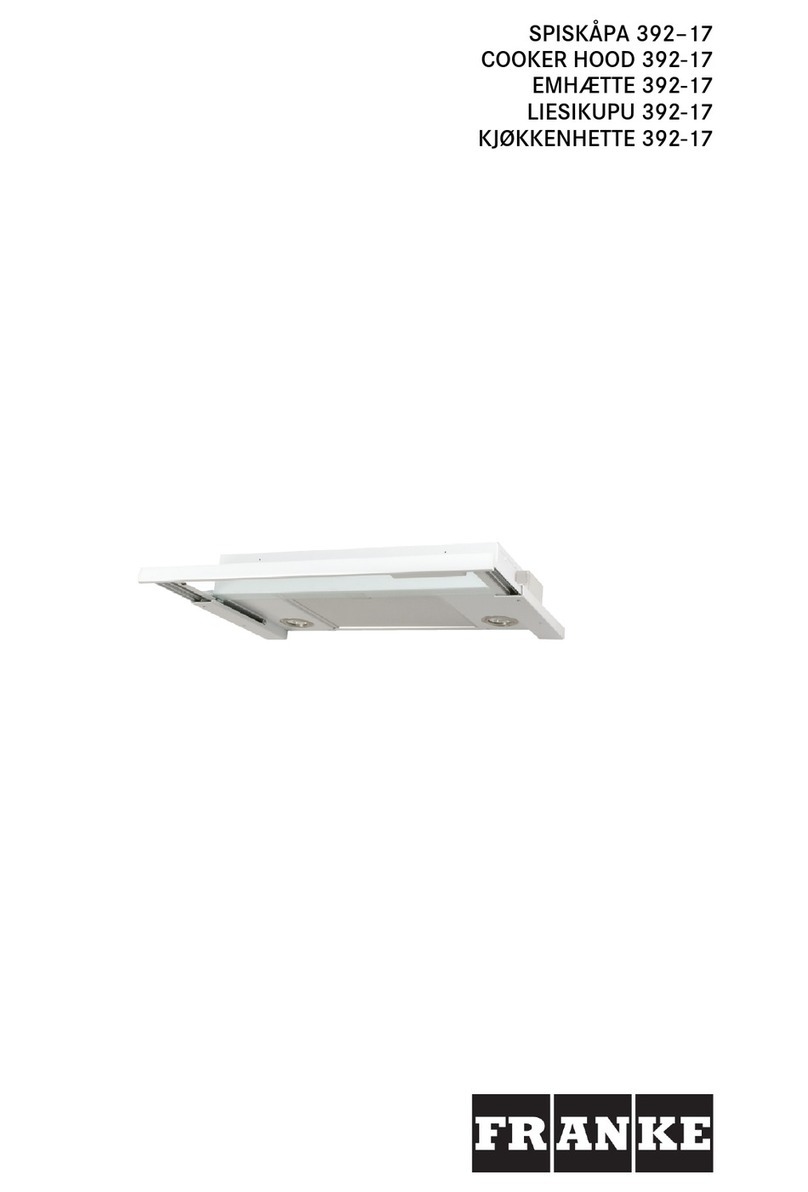GAYLORD XG-BDL Owner's manual

THE GAYLORD INSTALLATION,
OPERATION & MAINTENANCE MANUAL
for
“XG” SERIES HOODS
10900 S.W. AVERY STREET • TUALATIN, OREGON 97062 U.S.A.
1-800-547-9696 • 503-691-2010 • FAX: 503-692-6048 • email: inf[email protected]
GAYLORD INDUSTRIES
Revised 10-2015

To Our Customers. . .
Congratulations on your recent purchase of a Gaylord
kitchen exhaust hood system. We are proud to be able
to provide you with a quality product that incorporates
the latest engineering concepts and is a result of over 50
years of experience in the foodservice kitchen exhaust
industry.
If you have other Gaylord equipment such as a Gaylord
Utility Distribution System or Pollution Control Equipment,
etc., please refer to the corresponding supplementary
equipment manuals.
If you have further questions, please call us toll free at
1-800-547-9696. We are more than happy to help.
Sincerely,
Gaylord Industries
STREET ADDRESS: 10900 S.W. Avery Street, Tualatin, Oregon 97062 U.S.A.
PHONE: 503-691-2010 • 800-547-9696 • FAX: 503-692-6048 • email: info@gaylordventilation.com • www.gaylordventilation.com
GAYLORD INDUSTRIES, INC.
World Headquarters: 10900 S.W. Avery Street • Tualatin, Oregon 97062 U.S.A.
“Undisputed World Leader in
Engineered Systems for
Commercial Kitchens”tm
COMMERCIAL KITCHEN EXHAUST SYSTEMS • FIRE PROTECTION • UTILITY DISTRIBUTION • POLLUTION CONTROL

XG VENTILATOR MODEL DESCRIPTION ............................................................. 1
PRINCIPLES OF OPERATION ............................................................................... 4
MAINTENANCE AND CLEANING INSTRUCTIONS............................................... 5
UV START-UP PROCEDURES ............................................................................... 12
MEASURING AIRFLOW ......................................................................................... 14
TROUBLESHOOTING............................................................................................. 15
PARTS LIST ............................................................................................................ 21
SCHEMATICS ......................................................................................................... 26
INSTALLATION REQUIREMENTS.......................................................................... 30
HOOD START-UP INSPECTION REPORT............................................................. 31
WARRANTY
© Copyright 2008, Gaylord Industries
ADDITIONAL COPIES $10.00
The manufacturer reserves the right to modify the materials and
specications resulting from a continuing program of product
improvement or the availability of new materials.
ALL RIGHTS RESERVED. NO PART OF THIS BOOK MAY BE REPRODUCED, STORED IN
A RETRIEVAL SYSTEM, OR TRANSMITTED IN ANY FORM BY AN ELECTRIC, MECHANI-
CAL, PHOTOCOPYING, RECORDING MEANS OR OTHERWISE WITHOUT PRIOR WRITTEN
PERMISSION OF GAYLORD INDUSTRIES COPYRIGHT 2005.
TABLE OF CONTENTS

XG VENTILATOR MODEL DESCRIPTION
Model “XG-BDL”
APPLICATION - Wall mounted
canopy style
Enlarged Grease Cup to
Collect Captured Grease.
(Regular Service May be Required)
High Efciency XG Extractor.
Will remove up to 4 times as much
Grease as a Standard Bafe Filter...
Model “XG-BDL-DS-CL”
APPLICATION - Used for
cafeteria lines or any other
single line island arrangement
FIGURE 1
Standard Ventilator Models
FIGURE 2
XG-GFBD BDL
(Non-UV Hood Shown)
Model “XG-BDL-BB”
APPLICATION - Used for
typical island style back to
back cooking arrangement
1

1. Series
XG ....................................................
XG-UV ..............................................
2. Damper Type
GBD ..................................................
GFBD ................................................
ND .....................................................
3. Style
BDL ...................................................
BDL-CL .............................................
BDL-CS-CL .......................................
BDL-BBC-CL .....................................
BDL-BB .............................................
XG VENTILATOR MODEL DESCRIPTION
UV Service Doors
Only Approved Personnel Allowed
(Semi-Annual Service May be Required)
FIGURE 3
XG-UV-GFBD BDL Shown
Gaylord Ventilator model numbers are made up of an alphabetic prex followed by a series of alphabetic and/or numeric
sufxes to designate the style of the ventilator and various options. Sequence of model numbers are as follows:
1. ________
Series
2. ________
Damper
3. ________
Style
Explanation of Prefixes and Suffixes
Non water-wash ventilator with “XG” Super High Efciency Filtration Extractors
Non water-wash ventilator with “XG” Super High Efciency Filtration Extractors
with ultraviolet lamps.
Gaylord Balancing Damper (Manually Set)
Gaylord Fire Balancing Damper. Has a thermostatically activated (electric)
Fire/Balancing damper located at the duct collar. Can be used in the horizontal
position.
No Damper
Wall canopy style
Island style for single line of cooking equipment using one extraction chamber
(Light-Medium Duty)
Island style for single line of cooking equipment using one extraction chamber
(Light-Heavy Duty) – with ONE Heavy Duty piece of Cooking Equipment /
Section (max)
Island style for single line of cooking equipment using two extraction chambers
with one common exhaust duct (Light-Extra Heavy Duty) or Multiple pieces of
Heavy Duty Cooking Equipment.
Island style for back-to-back cooking equipment using two extraction cham-
bers. Has two separate exhaust ducts
2

3
OPERATION
FAN OPERATION
To operate the exhaust fan turn on the fan switch that
is typically mounted on a wall near the hood. The “XG”
hood may be equipped with a fan, auto start controller,
and/or light switch mounted on the face of the hood.
GREASE EXTRACTION
The Gaylord Industries Patent Pending “XG” Extractor
Cartridge is designed to deliver the absolute optimum
in collection efciency at the lowest possible pressure
drop. The units are ETL listed to UL 1046 standard, and
are also recognized as part of an “XG” Ventilator. They
are constructed of corrosion resistant stainless steel
and feature a “GX” style handle for easy removal from
the ventilator to which they are mounted. Another great
feature of the “XG” lter is that ut can be opened up and
turned back on itself for easy and efcient dishwasher
cleaning. The opening of the lter is accomplished by
a top mounted, dual hinge and a set of snap at the
bottom to secure the lter in position. The benet to
such a design ensures that the restaurant employee’s
will always have access to the inside of the extractors
for easy cleaning, and will not mistakenly install the
units in the opened, or disassembled position.
Optional Recessed Fluorescent or Incandescent Light
100 Watt Incandescent Light Fixture Standard
Optional Gaylord
Balancing or Fire
Balancing Damper
Available
3” min. air space
for compliance with
NFPA-96 when
mounting against
limited combustible
materials
UL 1046 Listed
High Efciency XG
Grease Extractor
Grease collection
drawer. Frequent
servicing may be
necessary.
When necessary
the plenum should
be wiped down
while lters are
being serviced
Extractor Removal
Tool should be
used to safely
remove Grease
Extractor(s)
Grease Collection
Drawer. Frequent
servicing may be
necessary.
Optional electric
Fire Damper.
System will activate
once thermostat
reaches set point.
UL 300 Plenum
Nozzle will activate
in the event of re.
UL 1046 Listed XG
Extractor subjected
to ame exposure
test as perscribed
in UL 1046.
Optional Thermostat
to detect internal res
sometimes not seen by
the operator
FIGURE 4
Grease Extraction
FIGURE 5
Cleaning
FIGURE 6
Fire Protection
Electric
Balancing
Control

4
PRINCIPLES OF OPERATION
UV Lamps
Systems incorporating UV lamps will have the extra added
benet of further break down of grease, in some cases down
to CO2, H20, and base minerals. The processes called
“Photolytic Oxidation”, and “Ozonolysis” are the drivers
behind keeping your ducts clean and free of containments
for much greater durations over conventional kitchen exhaust
systems not utilizing the UVC technology. The processes
break down, and condition grease dramatically reducing its
ability to burn or in some cases even combust. For proper
UV operation, the hoods must be maintained in good working
order. UV Lamps will accumulate a light gray dust on them
that will have to be periodically wiped off from below. Duct
work will have to be inspected in accordance with NFPA-96
or local guidelines, though frequency of duct cleanings will
be dramatically reduced.
Important Notice: Never operate your Ventilator without
the XG Extractors in place. The XG extractors are UL 1046
Flame Exposure tested to protect you’re your system from
penetration of fire into the exhaust duct. The XG Extractor is
also a light attenuation barrier to remain in place at all times
during the use of your UV system.
Cleaning
At the end of each cooking day the fan is to be turned off and
the XG Extractors are to be safely removed from the hood
and cleaned. The “XG” Extractors can be washed either
in a dishwasher or soaked and rinsed off. The XG lter has
a unique dual hinge design that will allow the extractor to
be opened so its internal components are accessible for
cleaning. Periodic internal scrubbing of the extractors may
be necessary in lines servicing busy kitchens, or lines using
sugary sauces or bastings.
The UV lamps will develop a coating of dust, and sometimes
debris that will have to be periodically wiped away to
optimize the UVC Systems performance. The lamps should
be inspected weekly once the lters are removed. When
necessary, the lamps can be cleaned from below by carefully
wiping the bulbs with a wet cloth using some mild detergent.
A maintenance rotation should be initiated at the point of
start up by a Gaylord Industries certied Service Agent to
address any maintenance, or repair issues that may be
required.
Fire Protection
NFPA-96 Requires the use of Surface Fire Protection
(Duct, Plenum, Surface/Appliance) on all hoods. It is these
systems that are the rst line of defense against equipment
res. Refer to the re extinguishing systems owner’s manual
for operation and maintenance instruction of for these
systems.
The XG-GFBD Series ventilator incorporates a re /
balancing damper in stalled in the duct collar to protect your
ducts, fans, and roof tops from the threat of re in the event
your primary re protection system fails to extinguish the re.
In the event of a re when the thermostat reaches its set
point of 325°F, the power to the hood will be cut allowing the
dual blade damper to spring shut sealing the duct entrance
and keeping the re contained in the plenum, where it can
be properly managed. Exhaust dampers are an excellent
way to protect your roof top and un-maintained grease ducts
from the threat of re.
The hood may also be supplied without a re damper, which
would be designated by either the sufx “ND” or GBD in the
model number. GBD designates a balancing ONLY damper.
Refer to the nameplate on the hood for the exact model
number designation.
GFBD Damper (Shown)
UV Access
(Keyed Latch)
XG Extractor
Grease Drawer
FIGURE 7
XG-UV-GFBD BDL

5
MAINTENANCE AND CLEANING INSTRUCTIONS
At the end of each cooking day, the exposed interior surfaces of the hood
should be wiped down and the grease cup emptied. During the course of
operation, grease particles are gradually collecting inside the “XG” extractors.
Daily, or at periodic intervals, depending on the type of cooking, the “XG”
extractors must be removed and cleaned. To clean, proceed as follows:
1. Remove extractors. CAUTION: Care should be taken when removing
extractors, especially over fryers. It is recommended that the cooking
equipment be cooled down and the fryers be covered prior to removing
extractors. To remove, lift up slightly on extractors and pull out at the
bottom, then straight down.
2. Extractors may be cleaned either by using a dishwasher or by soaking
in deep well sink using hot water with a degreasing detergent, scrubbed
and rinsed. Formula G-510 is highly recommended for this application.
For information contact:
20/10 Products
P.O. Box 7609
Salem, Oregon 97303
Phone: 800-286-2010
Fax: 503-363-4296
email: [email protected]
3. With extractors removed, wipe and clean the back wall and top of the
plenum area and the grease gutter with hot detergent water. NOTE: If a
steam or hot water pressure is used for periodic cleaning of the interior,
remove the grease cup and connect a hose to the gutter drain and lead
it to a oor sink or large bucket to drain off water.
4. When applicable, periodic cleaning of the UV lamps will be required. After
removing extractors for servicing, wipe the UV bulbs down with a clean
wet rag to remove any contaminants or grease that may have collected
on the lamps. Failure to maintain the cleanliness of the lamps will reduce
the UVC systems ability to keep the ducts and fans free of grease and
debris.
5. Replace extractors. Be sure to replace extractors with openings running
vertical as shown in FIGURE 9. Note: Extractor hinges shall always be
at the top when installed.
IMPORTANT NOTE: In the event of a re the thermostat must be replaced.
(Applicable to GFBD models only.)
INSPECTION AND CLEANING REQUIREMENTS
The 2007 edition of NFPA-96 (Standard for Ventilation Control and Fire
Protection of Commercial Cooking Operations) require that hoods, ducts
and exhaust fans be inspected by a properly trained, qualied and certied
company or person(s) in accordance with the following table.
Upon inspection, if found to be contaminated with deposits from grease-laden
vapors, the entire exhaust system shall be cleaned by a properly trained,
qualied, and certied company or person(s) acceptable to the authority
having jurisdiction in accordance.
When a vent cleaning service is used, a certicate showing date of inspection
or cleaning shall be maintained on the premises. After cleaning is completed,
the vent cleaning contractor shall place or display within the kitchen area a
label indicating the date cleaned and the name of the servicing company. It
shall also indicate areas not cleaned.
Factory trained service agencies are certified by Gaylord
Industries to perform these inspections. For the name and phone number of your
nearest agent call 1-800-547-9696 or go online to www.gaylordventilation.com
FIGURE 8
FIGURE 9
NOTE: NEVER OPERATE THE HOOD
IF THE FILTERS ARE NOT IN PLACE.
NOTE: FILTERS MUST BE INSTALLED WITH
BAFFLES RUNNING VERTICAL AS SHOWN.
CAUTION: Care should be taken when removing
extractors, especially over fryers. It is recommended
that the cooking equipment be cooled down and
the fryers be covered prior to removing lters.
ELUDEHCSNOITCEPSNIMETSYSTSUAHXE
snoitarepognikoocleufdilosgnivressmetsySylhtnoM
snoitarepognikoocemulov-hgihgnivressmetsyS
kowrogniliorbrahc,gnikoocruoh-42sahcus
gnikooc
ylretrauQ
gnikoocemulov-etaredomgnivressmetsyS
snoitarepo yllaunna-imeS
,snoitarepognikoocemulov-wolgnivressmetsyS
lanosaes,spmacyad,sehcruhcsahcus
sretnecroinesro,sessenisub
yllaunnA
NOTE: FILTERS SHOULD BE OPENED PRIOR TO
CLEANING
Listed Fire Damper
Access to lamps.
Clean UV lamps as
necessary
UV Module
FIGURE 10
Electric
Balancing
Control
Up Arrow to
Indicate this
side up

6
UV PREVENTATIVE MAINTENANCE
These items will need to be performed by a trained and qualied
Certied Service Agency (CSA) on the same schedule as the exhaust
system inspection schedule described in NFPA-96 and on the previous
page in this tech manual. These tasks involve potential exposure to
high doses of UV light and live electrical components. There is risk
of injury to skin and eyes and in the case of electrical shock, injury or
death! For a list of CSAs go to www.gaylordventilation.com and go to
“Service Agencies” for a list of companies nearest you.
1. Inspection of the Lamps and Ballasts
Check the lamps for proper operation
1. Turn on the fan and look for the green “UV System
On” light on each hood section
a. If it is not on refer to “UV Troubleshooting”,
pages 16 - 19.
2. Open the UV Access door with the key
3. Turn on fan
4. Verify all of the XG Extractors are installed.
5. Depress the UV Access door safety switch
6. Check all indicator LEDs, 6 green and 3 red, to
ensure that they are all on. If they are not all on go to
“UV Troubleshooting”, pages 16 - 19.
2. Inspect the Plenum (around the UV lamps)
a. Disconnect the UV module power cord
b. Remove the nuts holding the UV module to the ventilator
with a nut driver
c. Remove the UV module from the ventilator
d. Check for build-up of grease deposits.
e. Clean as necessary with a mild detergent, water and a
rag
f. Reinstall the UV module.
3. Test the Safety Interlock switches
a. Remove one “XG” Extractor with the fan on
• The UV lamps should shut off
• An audible alarm on the CUV-100 should come on
• The Red “UV Safety Interlock Activated” light on the
ventilator and CUV-100 control should come on
b. Open the UV Access door with the fan on
• The UV lamps should shut off
• An audible alarm on the CUV-100 should come on
• The Red “UV Safety Interlock Activated” light on the
ventilator and CUV-100 control should come on
c. To test Pressure Switch turn off the breaker to the
Exhaust Fan. Press the “Start Fan” button on the CUV-
100 control
• After a 1 minute delay, the UV lamps should shut off
(stay off)
• An audible alarm on the CUV-100 should come on
• The Red “UV Safety Interlock Activated” light on the
ventilator and CUV-100 control should come on
4. Check all gaskets for damage
a. Replace any gaskets that are worn or damaged only with
factory provided replacements.
5. Check the Hour Meter
a. Record the hours
b. Determine the approximate hours between inspection
intervals.
c. Determine when the 8000-hour life of the lamps will
occur and inform the operator of the approximate date
when the lamps will need to be replaced.
Replacing UV Lamps
Danger!
These items will need to be performed by a trained and qualied
Certified Service Agency (CSA). These tasks involve potential
exposure to high doses of UV light and live electrical components.
There is a risk of serious injury to skin and eyes from UV light. There
is risk of shock, injury, and/or death from electrical. For a list of CSA’s
go to www.gaylordventilation.com and go to the “Service Agencies”
for a list of certied companies nearest you.
1. Secure all power to the CUV-100 control
2. Secure all circuits that provide power to the UV lamps
3. Open the UV Access door with the key
4. Disconnect the UV module power cord
5. Remove the nuts holding the UV module to the ventilator with
a nut driver
6. Remove the UV module from the ventilator
7. Remove the bolts on each end of the UV module (2 on each
end) that hold the end caps on. (see below)
8. Disconnect the lamp connector(s) on the UV lamp(s) to be
replaced
• Each lamp connector should be labeled from 1 to 6 on
both ends
• Lamp #1 is at the Front of the ventilator when the UV
module is installed
• Lamp #6 is at the Back of the ventilator when the UV
module is installed
• Be sure to re-label the lamp connectors if necessary
9. Lubricate the lamps around the grommets on each end of the
UV lamp with a small amount of G-510 or similar detergent
10. Slide the UV lamp out one end, CAREFULLY!
11. Inspect the grommets around the lamps
• Replace any grommets that show cracks, or any other
damage
Warning: Do NOT defeat any interlocks during cleaning and maintenance!
CERTIFIED SERVICE AGENT MAINTENANCE WARNING!
UV Lamp
Grommet
UV Module
Lamp Connector
Red Silicone Gasket
Module End Cap
Nylon Washer
1/4 - 20 Bolt
FIGURE 11

7
UV PREVENTATIVE MAINTENANCE CONTINUED
SAFETY CONCERNS WITH UVC
12. Check all wires for damage
• Replace any wires showing damage
13. Lubricate each of the new UV lamp(s) before installing with a
small amount of G-510 or similar detergent
14. Re-connect the lamp connectors on both ends of the UV lamps
• Each lamp connector should be labeled from 1 to 6 on
both ends
• Lamp #1 is at the Front of the ventilator when the UV
module is installed
• Lamp #6 is at the Back of the ventilator when the UV
module is installed
15. Re-install the UV module end caps and torque the bolts to
7-10 in-lbs.
16. Re-install the UV module in the ventilator
17. Tighten all nuts holding the UV module to the ventilator
18. Re-connect the UV module power cord
19. Check for proper operation of UV lamps & interlocks
Warning: Do NOT defeat any interlocks during cleaning and maintenance!
CERTIFIED SERVICE AGENT MAINTENANCE WARNING!
UV Chase
UV Module
FIGURE 12
As with many types of technology if it is not used properly and/or
proper precautions are not taken there is the potential for injury
or harm. This is especially true with UVC light due to the fact that
it does not physically hurt at the time of exposure. While UVC is
very effective at breaking down grease molecules, direct exposure
to large amounts is harmful to skin and eyes. The amount of UVC
generated in these hoods is greater than that what results from
direct exposure to the sun. Under no circumstances is it acceptable
to view the lighted lamps without proper eye protection or expose
bare skin directly to the light. All interlocks and safety precautions
called for in this manual must be followed to avoid the potential for
harm to service personnel and/or operators. In addition, only trained
and authorized personnel may perform some maintenance See
previous page for details.
Personal Protective Equipment
1. Eye protection that prevents 100% of UVC being transmitted
through the lens must be worn at all times when performing
service work on any Ultima Vent that is energized and/or has
the potential to be energized and expose personnel to UVC
light.
2. Whenever service work is performed it is recommended that
long sleeve pants and shirts be worn to minimize the potential
for inadvertent exposure of the skin to UVC.
Safety Interlocks
This product comes equipped with the following sensors to verify that
all access doors are in place and that the exhaust fan is running:
1. Mechanical door switch on the UV Access door to ensure that
the door is closed
2. XG Extractor magnetic switches to ensure each extractor is
installed.
3. Air Pressure switch to verify air ow and exhaust fan
operation
All of these devices must be working and/or adjusted properly in
order for the system to operate properly.

8
OPTIONAL FIRE / BALANCING DAMPER GBD SERIES
Gaylord System Balancing (GBD)
The XG Series Ventilator will optionally come with a Gaylord
Industries Listed balancing damper. The options available are the
GBD-IS (balancing only damper), and the GFBD (Fire Balancing
damper). The GBD-IS is set from below and performs the task
of raising or lowering the exhaust airow to any section that it is
installed on. The GFBD is a re / balancing damper that will close
upon detection of any internal re burning inside the plenum. The
thermostat for the XG series Ventilator is set to 325°F, and must
be factory installed. The balancing of the GFBD is done by way of
a potentiometer found in the UV electrical chase, (see Figure 19)
or in the thermostat chase shown in Figures 4 & 8. The GFBD is
intended to close upon the deactivation of the exhaust fan every
night. The feature is intended to eliminate cool air from drafting
down the exhaust ducts, and entering the kitchen.
Both the GFBD, (shown in Figure 14), and the GBD are not advised
for use over solid fuel applications, and should be inspected at least
semi annually with the rest of the exhaust system.
For further details on the Gaylord Industries commercial kitchen
exhaust dampers, please consult the GBD technical manual.
FIGURE 13
FIGURE 14
GFBD Commercial Fire / Balancing Damper
FIGURE 15
GBD “DSD” Damper Set Dimension
The adjustment of both systems relies on the internal dimension between
the two blades. Called the “DSD”. The manipulation of that distance will
accomplish your air balancing needs. See Figure 15, above, the GBD
Technical Manual, and “Measuring Airow” in this manual for more
details.
Damper Motor
Self Locking
Fastener
Damper Blade
Brass Support
Ring
Oil Seal

9
GFBD INTERNAL WIRING / SINGLE SECTION
XG Damper #1
Part #19176
(At Duct Collar)
XG Damper #1
Part #19176
(At Duct Collar)
Positioner #1
Part #18876
(Access from below)
FIGURE 16
GFBD Internal Wiring Diagram

10
GFBD EXTERNAL WIRING / MULTIPLE SECTION
FIGURE 16B
GFBD External Wiring Diagram

11
The UV Hood Wiring Board is an integral part of the UV interlock
system. All interlock activations are indicated by the LED’s next to
each component wire attachment. The Magnetic Switches used
to determine if the lters are in place are broken down into groups
of four switches, shown below. If any switch fails the group of four
switches will turn off the LED at the point of connection to the UV
Hood Wiring Board. To determine the bad switch or magnet you will
need to use a voltmeter with continuity detection. You will then need
to check the continuity across each switch on that circuit. Ex: To do
so for Extractor #9 check for continuity across F9 & F9. To check
Filter 10, check for continuity between F9 & F10. (See Page 25 for
diagram) Once repaired or replaced the LED should again light up
when all XG Extractors are in place. (see below for more detail)
UV HOOD WIRING BOARD
UV System Interlock
Connections. Pull to
disconnect.
Fuse Protection for UV
Modules Rated at 15
AMP
120 / 240 VAC jumper
must be in 120 VAC
position for domestic
applications
Magnetic Switch
terminal blocks located
in UV electrical chase
next to UV hood wiring
board
Note:
Individual magnetic switches can be
troubleshot on these terminal blocks.
Voltmeter with continuity required to
test system.
Board LEDs will
light up when
good

12
UV START-UP PROCEDURES
Start-up requirements and activities
At the time of shipment a Certied Service Agent (CSA)will be
selected to perform the installation of the UV modules and the
start-up for the Ultima Vent system.
The Service agent should conrm the following prior to going to
the job site:
1. The Exhaust and Supply fan(s) are connected to the ductwork
2. The fans have electricity and will run
3. The CUV-100 control panel is mounted and has the following:
• Power to the CUV-100
• All necessary electrical connections between the CUV-100
and the hood, surface re protection system, and fans.
4. All lighting wiring is connected to the hoods and light switch
5. There is a 120 Volt, 20 Amp power circuit going to each individual
hood section, for UV lamps
6. Any personnel (Fire Marshal, owners rep., GC, FP contractor,
air balancer, etc) required to witness the start up would need
to be notied of time and date for start-up.
Field Start up directions
Allow about 1 hour per hood section, at the job site, for the activities
described below:
1. Check for power to the CUV-100 and wiring between the CUV-
100 and the hoods
2. Check that all XG Extractors are properly installed
3. Start the exhaust fan by turning the CUV-100 control on. Both
supply and exhaust fans should start. The green “UV System
On” light should be on. If this does not occur refer to “UV
Troubleshooting” on pages 14 - 19.
4. Turn CUV-100 control off. This will shut off the fans.
5. Open the UV Access door and remove the blank plate from the
UV light opening.
6. Install the UV light modules in the hood. Connect the plug on the
UV module to the hood, and secure the module in place.
7. Start the exhaust fan and check for the green “UV System On”
light at the hood(s) and control panel. Make sure that all access
doors are closed.
8. Check the plenum pressure at the static pressure tap. See page
12 for details.
9. Record the data on the start up form. Determine the correct
static pressure and record that in the design velocity location.
Then determine the percentage of design that the actual air
static pressure represents
10. Remove an XG Extractor
• The red “Safety Interlock Activated” lamp should come on and
an audible alarm sound.
11. Check the UV Access door interlock
• Open the UV Access door with the fan on.The red “Safety
Interlock Activated” lamp should come on and
an audible alarm will sound.
Caution: Before any Fire tests are performed, check with the
building superintendent to see if the Surface Fire Protection
system is wired to the building alarm, monitoring system, and/
or re department.
12. If the FP contractor is there have them trip the micro switches
on the FP system to verify that the Exhaust Fan(s) starts and
supply Fan(s) shut off, or perform as required.
13. Once all is working correctly demonstrate the following to the
end user
• If the hood is interlocked with the FP system. Have the
FP contractor test it and conrm that the External re
mode works properly.
• Instruct them that if for any reason they can see the UV
light directly they must shut off the hood immediately
and call a CSA.
• Check for proper damper operation if this hood has a
GFBD Fire / Balancing Damper. Damper will close once fan
is deactivated.
• How to remove, clean and replace the XG Extractors
• That they need to perform the required end user maintenance
described in the tech manual, hire a CSA to perform the UV
maintenance as described in the tech manual, and have the
duct system inspected/or cleaned as per the requirements
of NFPA-96, or their local authority.
• The frequency will need to be adjusted based on the
type, amount and duration of cooking done at this site.
• Fill out the start up form completely with comments
• Notify the Dealer/customer if the air volumes are more
than 5% low or 15% high and give the dealer and GC
a copy of the Start-up report.
• Send a copy of the Start-up report to Gaylord and keep a
copy for your records.
Before using the XG Series Ventilator a complete and thorough start-up of the system must be performed by a qualied, and authorized service
technician. Because of this the UV modules will be shipped separate from the hood to an Certied Service Agent (CSA). Contact Gaylord
Industries to arrange for this service. It is normally included in the purchase price of the hoods.

13
MEASURING AIRFLOW
Measuring Airflow (Single Section)
The XG hood has been designed to give you an approximate airow
per linear foot of hood based on the static pressure measured at
each section. The static tap, as seen below in gs. 17 & 18 will be
located behind a small 4 to 6 screw access cover in the case of
the non-UV hoods, and inside the UV electrical chase on the UV
ventilators. The method will require a manometer, (Dwyer 475-00
FM recommended), to be used to take your measurements. After
obtaining your measurement the value(s) are to be compared to
table 3 to get your ow rate per linear foot of hood. The value is then
multiplied by the length of the hood in feet to get your total airow
for that particular section. Multiple section balancing will require
the use of a GFBD, or GBD balancing damper, and some tweaking.
Most GBD and GFBD dampers will be factory preset if conditions
permit. All airow data should be recorded at the time of start up
and inspected every 1 to 2 years for proper ow.
Instructions (Single Section Measurement):
1. Turn on the exhaust fan to the hood section you intend to
measure the exhaust airow.
2. Remove access cover as seen in fig. 17, or 18 for UV
systems.
3. Locate the static tap, and remove the sealing boot.
4. Zero you Dwyer 475-00 Digital Manometer.
5. Take the 1/8” vinyl tube attached to your Dwyer 475-00 Digital
Manometer and attach it to the static tap.
6. Record the value indicated on your meter.
7. Obtain ow rate per length of ventilator from chart 6 below.
8. Multiply ow rate by length of ventilator in feet.
9. Conrm measured air ow rates match design rates. Design
values will be noted on the hood’s listing label attached to the
inside of the ventilator, or a sticker attached to the inside of the
access cover.
10. Acceptable ow rates will be no more than 5% low to 10%
high.
Measuring Airflow (Multiple Section)
During the course of the start up the Gaylord Industries representative
or balancer will have to balance all hoods common to a single fan
simultaneously. This process will require knowledge of the ducting,
and a little technique. Prior to starting the process the Balancer will
have to verify the preset on all GBD and/or GFBD Dampers.
To Preset the Gaylord Industries balancing dampers, the balancer will
have to know both the intended plenum and trunk static pressures.
This can be done by obtaining a set of the design drawings for each
job, Gaylord Industries to provide. After obtaining both the main trunk
static pressure common to all hoods on that fan you will need to
subtract the plenum pressure from the value for each hood section.
For example: If you have 1.00” WC at the duct collar but only 0.23
inches of static in your hood’s plenum. The balancing damper will
have to be adjusted to make up the difference; in this case it will have
to make up 0.77 inches of static pressure, 1.00 WC – 0.23 WC = 0.77
WC. The difference between the collar and plenum pressure, 0.77
inches in this case, will have to be compared to the ow characteristic
chart, g. 20 to get a preset place to start. The preset value is the
inside distance between the two center blades, in this example it is
1 5/8” for hoods with 1500 FPM duct velocities, and 2 5/8” for duct
velocities running at 1800 FPM. The dimension is called the DSD,
“Damper Set Dimension”. It is our reference for the rst set in the
balancing process. Typically the “DSD” will be factory preset. GFBD
models rely on a potentiometer to set the values, see g. 19 for the
correlation between the DSD, and the potentiometer dial.
After conrming your preset values to the Dampers, you will verify
the ow through each hood section starting with the heaviest line
rst, and working your way down to the lightest. You will need to
record the ow rates for each section, then go back and adjust again
as needed to achieve your design airow rates.
Static Pressure
Tap
Access Cover
FIGURE 17
Static Pressure Tap (Non-UV)

14
System Testing
Prior to testing the hoods performance all make up air registers,
should be noted, and measured for airow, equipment should be in
the push back position, as close as possible to the rear wall. Any
doors, or cross drafts in the vicinity of the hood’s should be noted,
and lastly and lastly, all observations, and values need to be recorded
and provided to Gaylord Industries for safe keeping.
GFBD (%) DSD (in)
100 4 1/16
90 3 7/8
80 2 15/16
70 2 1/8
60 1 1/2
50 15/16
40 3/8
BDL Hood DS-CL Hood
SP Tap CFM / LF SP Tap CFM / LF
0.07 100 0.10 200
0.10 120 0.12 240
0.15 150 0.15 280
0.19 170 0.17 300
0.23 190 0.21 340
0.28 210 0.25 380
0.30 220 0.34 440
0.36 240 0.37 460
0.43 265 *Values need to be
multiplied by the hood
section overall length to
get the total CFM.
0.55 300
0.63 320
0.75 350
GBD / GFDB Flow Characteristion Chart
0.20
0.40
0.60
0.80
1.00
1.20
1.40
1.60
0.00 1.00 2.00 3.00 4.00
DSD, (Damper Set Position) (Measured Center Opening Dimension, inches)
SP Adder to Plenum Pressure, (WC)
SP adder (1500 FPM)
SP adder (1800 FPM)
1800 FPM
1500 FPM
Gaylord Balancing
Damper
Chart will indicate the DSD as it relates to the dial adjuster for
GFBD models only.
Static Pressure
Tap
Access to Static
Pressure Tap
FIGURE 18
Static Pressure Tap (UV Hood)
FIGURE 20
Damper Set Position Chart
FIGURE 21
Airow Chart
FIGURE 19
GFBD Correlation Chart
MEASURING AIRFLOW

15
TROUBLESHOOTING
SYMPTOM POSSIBLE PROBLEM CORRECTIVE ACTION
SMOKE LOSS
1. Smoke Loss - Hood is not exhausting
properly.
A. Low Airow - Static pressure at the
hoods static tap. Static values should
be in accordance with Figure 21.
1. Broken or slipping belt on the exhaust
fan.
2. Proper rotation of the exhaust fan
wheel.
3. Proper size of the exhaust fan (fan
must deliver nameplate rating).
4. Ductwork inspection panel left open.
5. Exhaust duct re damper not open or
in proper position
B. The hood must have its own exhaust
system and no other exhaust, such
as dishwasher hoods, should be tied
into it.
1. Inspect duct system and verify that
there are no other non hood systems
tied in. If so, they must be removed.
C. Improperly placed make-up air
diffusers
1. Make-up air directed at the hood will
likely create cross drafts disrupting
the airow into the hood. Adjust the
louvers to direct the make-up air away
from the hood.
2. Make-up air should be delivered
through the registers at ceiling height,
and distributed throughout the kitchen
area.
3. Make-up air registers located near the
hood, the louvers should be adjusted
to direct the air away from the hood.
Directing or forcing make-up air at the
hood typically creates cross drafts
resulting in smoke loss. Ceiling make-
up air should not exceed 150 FPM at
the inlet.
E. Exhaust fan discharge. 1. There should be no screen over the
discharge. If one is found, it should be
removed.
2. The direction of discharge should
not be into the prevailing winds nor
downward onto the roof. A vertical
discharge is highly recommended.
GREASE EXTRACTION
1. Poor Grease Extraction A. Hoods with too much air being pulled
through them can have grease pull
through.
1. To see if you are pulling the proper
amount of air through the system, see
Figure 21.
2. Wash XG Extractors more frequently.
3. Noise B. Hoods pulling too much air through
the extractor can cause excessive
noise.
1. Adjust motor / fan speed down to
eliminate excessive noise. After
doing so, verify the hood is properly
capturing all smoke.
2. Adjust GBD damper up or down as
needed to eliminate noise. Watch for
changes in other hood’s ow rates as
a result of damper manipulation.

16
TROUBLESHOOTING
SYMPTOM POSSIBLE PROBLEM CORRECTIVE ACTION
EXHAUST FAN
1. If the fan switch is turned on to the
exhaust position but the exhaust fan
does not come on.
A. Overload protector on the magnetic
starter tripped.
1. Push the “Reset” button on the
magnetic starter and turn the fan
switch to the “On” position.
B. If the HOA (Hand Off / Automatic) type
magnetic starter switch is used, the
selector switch may have been moved
from the automatic position.
1. Check switch and turn selector to the
automatic position.
C. Exhaust fan circuit breaker tripped. 1. Re-set circuit breaker.
D. If the system is equipped with a fused
disconnect switch for the exhaust fan,
a fuse or fuses may have blown out.
1. Check continuity of fuses and replace
if necessary.
E. Fan on / off switch has not been wired
properly.
1. Refer to wiring diagram in this manual
and re-wire.
2. If when the fan switch is turned on to
the exhaust position, air is not being
pulled through the hood but you can
hear the fan running.
A. Fire damper at exhaust collar, if
equipped, has closed.
1. Open necessary access panels to
duct collar, inspect and take corrective
action.
2. Verify damper motor proper operation
and that it is getting its requirement of
power.
B. Fan drive belt is slipping 1. Tighten belt then verify airow
C. Fan is running in reverse 1. Contact electrical contractor to wire
correctly.
Total Exhaust CFM Here
FIGURE 22
ETL Listed Nameplate
The total minimum required
exhaust volume can be
found stamped on the ETL
nameplate located on each
hood section. Minimum
listed values do not always
correspond to the design
requirements for each hood
section.

17
TROUBLESHOOTING UV SYSTEM
SYMPTOM POSSIBLE PROBLEM CORRECTIVE ACTION
1. After CUV-100 is turned on, fan starts:
• Yellow “UV Lamp Failure” light is on
• Audible alarm is on
A. No power to the ventilator section(s). 1. Check for 120v between L1 & L2 at
ventilator. If there is no power at L1
& L2 coming to this ventilator section
identify the circuit breaker, correct and
re-check.
B. Loose wire between CUV-100 and
ventilator.
1. Check for 120v between 6U & 5U in
the ventilator. If none, check CR13 in
the CUV-100 for power and operation.
If there is power there, check for 120v
between 1U & 5U. If there is power,
check the green lamps for proper
operation.
C. No start signal from CUV-100 to
ventilator section(s).
1. Check fuse F7 in CUV-100.
D. Fuse is blown on UV Module
Controller in ventilator.
1. Check fuse F2 on the UV Module
Controller.
E. Fuse is blown on UV Hood Wiring
Board.
1. If there is power at L1 & L2, check for
power to 5A & 6A on UV Hood Wiring
Board.
F. Green “UV System On” light has
failed.
1. Check for power to the Green “UV
System On” light
• If no power, check the circuit and
located problem.
• If there is power, the Green “UV
System On” light has failed and
needs to be replaced.
2.
• Yellow “UV Lamp Failure” light is on
• Green “UV System On” light is on
• Audible Alarm is on
A. UV Lamp or UV Ballast has failed. 1. Identify ventilator section with Yellow
“UV Lamp Failure” light on.
2. With fan running, open UV Access
Door.
3. Depress the UV Access Door switch
and identify which Lamp / Ballast’s
green light is not on.
4. Switch the pin connector on that
Ballast with another Ballast and check
again
• If the alternate Ballast’s green light
comes on, replace the Ballast
• If the alternate Ballast’s green light
does not come on, replace the
Lamp
B. The contacts on the UV Module
Controller have closed permanently.
Failed relay chip.
1. Check for continuity between 2A &
3A in ventilator. If there is continuity
AND all of the UV lamps are working,
(6) green and (3) red lights lit on the
UV Module Controller, the UV Module
Controller needs to be replaced.
C. Relay CR12 in CUV-100 has failed. 1. Check CR12 for proper operation,
replace if necessary.
3.
• Yellow “UV Lamp Failure” light is on
ONLY at CUV-100 control NOT on
any of the ventilator sections.
• Green “UV System On” light is on
• Audible alarm is on.
A. Yellow “UV Lamp Failure” light on
ventilator has failed.
1. Check the Yellow “UV Lamp Failure”
light and see if it is receiving power.
• If no, the problem is in the wiring.
Locate and correct the problem.
• If yes, replace the lamp.
Danger!
These items will need to be performed by a trained, qualied and
Certied Service Agency (CSA). These tasks involve potential
exposure to UV light and live electrical components. There is a risk
of injury to skin and eyes and in the case of electrical shock, injury
or death! For a list of CSA’s go to http://www.gaylordventilation.com
and go to Service for a list of companies nearest you.
This manual suits for next models
2
Table of contents
Other GAYLORD Ventilation Hood manuals
Popular Ventilation Hood manuals by other brands
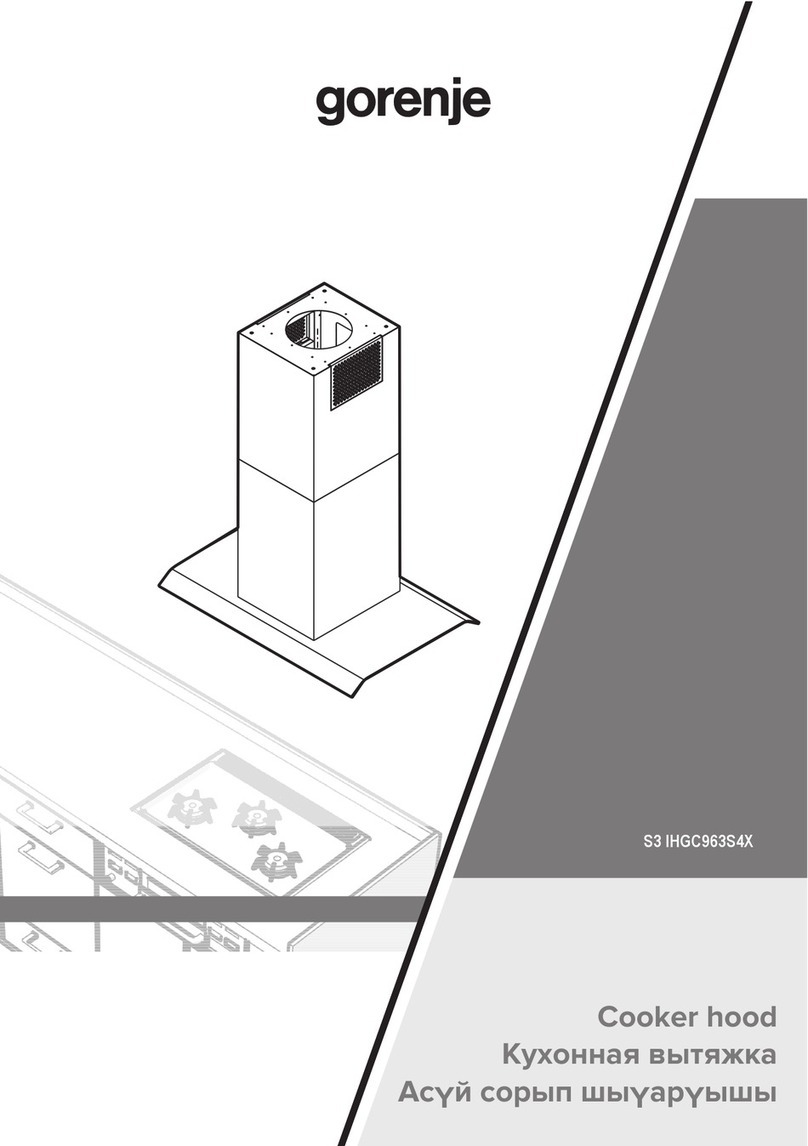
Gorenje
Gorenje S3 IHGC963S4X manual

KOBE
KOBE ISX2136SQB-1 Installation instructions and operation manual

U.S. Products
U.S. Products ADVANTAGE-100H Information & operating instructions

Kuppersberg
Kuppersberg DUDL 4 LX Technical Passport
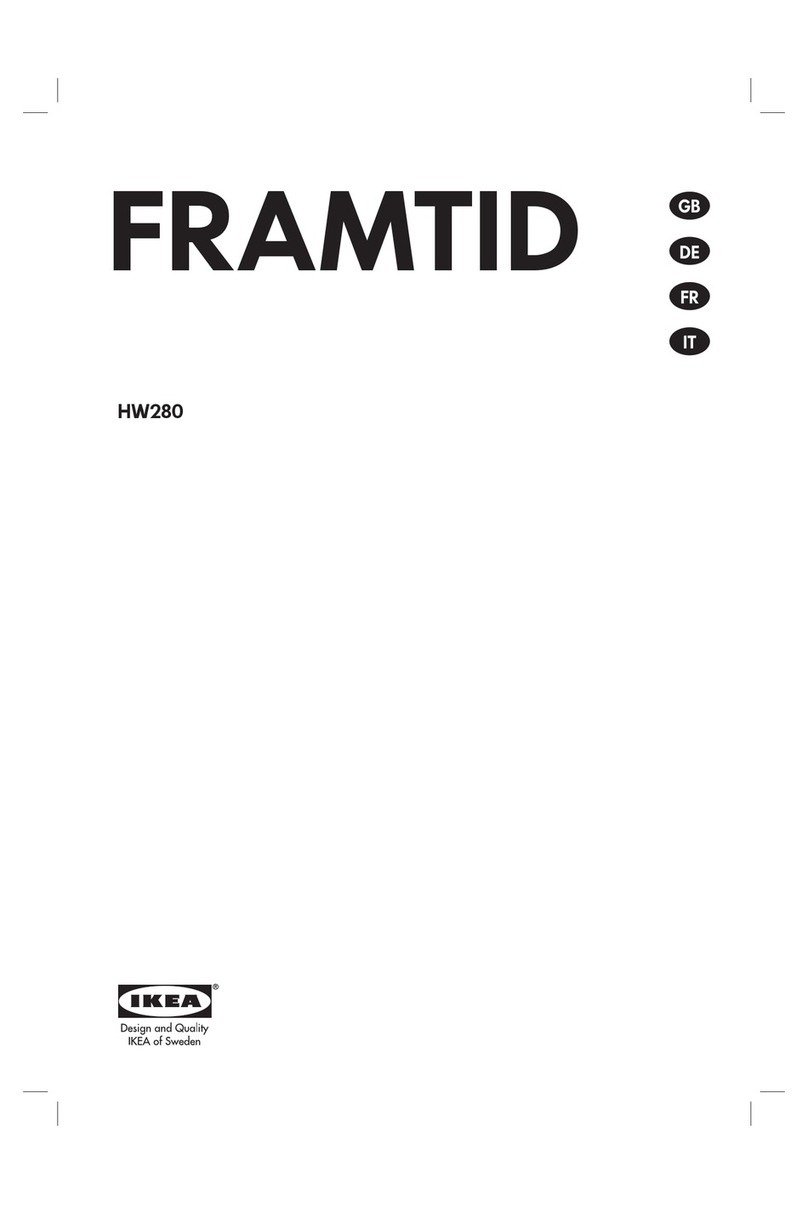
Framtid
Framtid HW280 manual
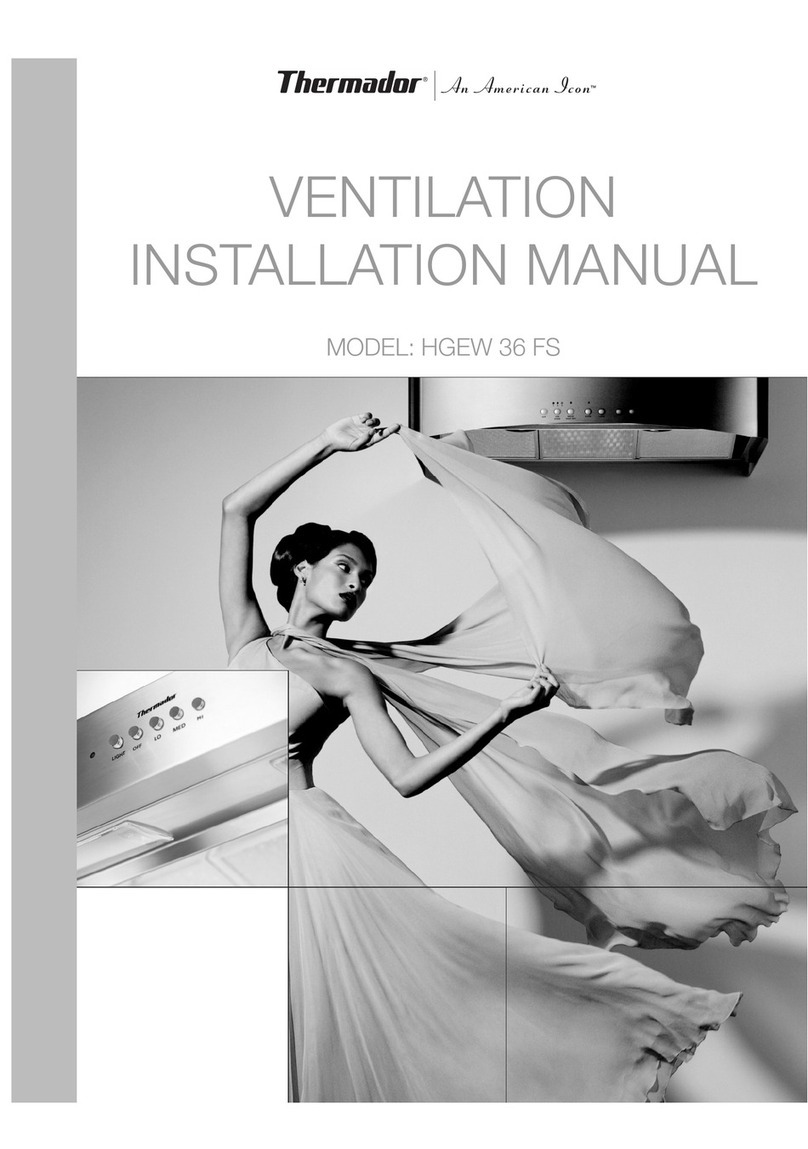
Thermador
Thermador HGEW 36 FS installation manual



